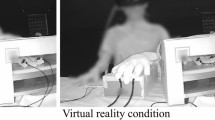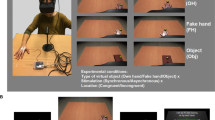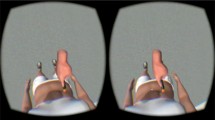Abstract
The traditional rubber hand illusion is a psychological experiment where participants are under the illusion that a rubber hand is part of their own body. This paper examines the use of real, virtual and augmented reality environments for identifying the elements that influence body ownership in healthy participants. Compared to the classical experiment where a plastic rubber hand was used, a realistic 3D representation was chosen to create the same illusion this time in both immersive virtual reality and augmented reality. Experiments were performed on 30 volunteers undergoing testing session composed of three stages. Participants were asked to complete two different questionnaires, one measuring their cognitive workload and another one regarding their experience with the rubber hand illusion. In addition, EEG signals of the individuals were recorded, resulting in 90 electroencephalogram datasets. Results indicate correlations between ownership statements with beta and gamma electroencephalogram bands in premotor cortex activity. Link between higher gamma production in ventral premotor area during the illusion was established in previous studies.





Similar content being viewed by others
Explore related subjects
Discover the latest articles, news and stories from top researchers in related subjects.References
Artoolkit. http://www.hitl.washington.edu/artoolkit/. Accessed 11 Dec 2015 (2015)
Create and connect with unity 5. http://unity3d.com. Accessed 11 Dec 2015 (2015)
Fortus 250mc. http://www.stratasys.com/3d-printers/design-series/fortus-250mc. Accessed 11 Dec 2015 (2015)
Mara plug-in for eeglab. http://www.user.tu-berlin.de/irene.winkler/artifacts/. Accessed 11 Dec 2015 (2015)
Mirror: medical imaging software. http://www.canfieldsci.com/imaging-systems/mirror/. Accessed 11 Dec 2015 (2015)
Products/enobio/enobio 32-neuroelectrics. http://www.neuroelectrics.com/products/enobio/enobio-32/. Accessed 11 Dec 2015 (2015)
The wrap 1200dxar—the ultimate digital ar eyewear solution. https://www.vuzix.com/augmented-reality/products_wrap1200dxar/. Accessed 30 Nov 2015 (2015)
Baillet, S., Mosher, J.C., Leahy, R.M.: Electromagnetic brain mapping. IEEE Signal Process. Mag. 18(6), 14–30 (2001)
Başar-Eroglu, C., Strüber, D., Schürmann, M., Stadler, M., Başar, E.: Gamma-band responses in the brain: a short review of psychophysiological correlates and functional significance. Int. J. Psychophysiol. 24(1), 101–112 (1996)
Botvinick, M., Cohen, J., et al.: Rubber hands’ feel’touch that eyes see. Nature 391(6669), 756–756 (1998)
Brovelli, A., Lachaux, J.P., Kahane, P., Boussaoud, D.: High gamma frequency oscillatory activity dissociates attention from intention in the human premotor cortex. Neuroimage 28(1), 154–164 (2005)
Costantini, M., Haggard, P.: The rubber hand illusion: sensitivity and reference frame for body ownership. Conscious. Cognit. 16(2), 229–240 (2007)
Delorme, A., Makeig, S.: Eeglab: an open source toolbox for analysis of single-trial eeg dynamics including independent component analysis. J. Neurosci. Methods 134(1), 9–21 (2004)
Ehrsson, H.H.: The experimental induction of out-of-body experiences. Science 317(5841), 1048–1048 (2007)
Ehrsson, H.H., Holmes, N.P., Passingham, R.E.: Touching a rubber hand: feeling of body ownership is associated with activity in multisensory brain areas. J. Neurosci. 25(45), 10564–10573 (2005)
Ehrsson, H.H., Spence, C., Passingham, R.E.: That’s my hand! activity in premotor cortex reflects feeling of ownership of a limb. Science 305(5685), 875–877 (2004)
Fernández, T., Harmony, T., Rodríguez, M., Bernal, J., Silva, J., Reyes, A., Marosi, E.: EEG activation patterns during the performance of tasks involving different components of mental calculation. Electroencephalogr. Clin. Neurophysiol. 94(3), 175–182 (1995)
Fitzgibbon, S.P., Pope, K.J., Mackenzie, L., Clark, C.R., Willoughby, J.O.: Cognitive tasks augment gamma EEG power. Clin. Neurophysiol. 115(8), 1802–1809 (2004)
Gallagher, S.: Body image and body schema: a conceptual clarification. J. Mind Behav. 7(4), 5417,554 (1986)
Graimann, B., Allison, B.Z., Pfurtscheller, G.: Brain–Computer Interfaces: Revolutionizing Human–Computer Interaction. Springer Science & Business Media, Berlin (2010)
Gray, C.M.: The temporal correlation hypothesis of visual feature integration: still alive and well. Neuron 24(1), 31–47 (1999)
Hart, S.G.: Nasa-task load index (nasa-tlx); 20 years later. In: Proceedings of the human factors and ergonomics society annual meeting, vol. 50, Sage Publications, pp. 904–908 (2006)
IJsselsteijn, W., de Kort, Y., Haans, A., et al.: Is this my hand i see before me? the rubber hand illusion in reality, virtual reality, and mixed reality. Presence 15(4), 455–464 (2006)
Kalckert, A., Ehrsson, H.H.: Moving a rubber hand that feels like your own: a dissociation of ownership and agency. Front. Hum. Neurosci. 6(40), 1–14 (2012)
Kalckert, A., Ehrsson, H.H.: The moving rubber hand illusion revisited: comparing movements and visuotactile stimulation to induce illusory ownership. Conscious. Cognit. 26, 117–132 (2014)
Kammers, M., Van der Ham, I., Dijkerman, H.: Dissociating body representations in healthy individuals: differential effects of a kinaesthetic illusion on perception and action. Neuropsychologia 44(12), 2430–2436 (2006)
Kilteni, K., Maselli, A., Kording, K.P., Slater, M.: Over my fake body: body ownership illusions for studying the multisensory basis of own-body perception. Front. Hum. Neurosci. 9, 1–20 (2015)
Lenggenhager, B., Tadi, T., Metzinger, T., Blanke, O.: Video ergo sum: manipulating bodily self-consciousness. Science 317(5841), 1096–1099 (2007)
Maravita, A., Spence, C., Driver, J.: Multisensory integration and the body schema: close to hand and within reach. Curr. Biol. 13(13), R531–R539 (2003)
Martin, J.H.: The collective electrical behavior of cortical neurons: the electroencephalogram and the mechanisms of epilepsy. Princ. Neural Sci. 3, 777–791 (1991)
Merleau-Ponty, M.: Phenomenology of Perception (1962)
Petkova, V.I., Ehrsson, H.H.: If i were you: perceptual illusion of body swapping. PLoS ONE 3(12), e3832 (2008)
Pfurtscheller, G., Neuper, C.: Motor imagery and direct brain-computer communication. Proc. IEEE 89(7), 1123–1134 (2001)
Pulvermüller, F., Birbaumer, N., Lutzenberger, W., Mohr, B.: High-frequency brain activity: its possible role in attention, perception and language processing. Prog. Neurobiol. 52(5), 427–445 (1997)
Ramachandran, V.S., Rogers-Ramachandran, D.: Synaesthesia in phantom limbs induced with mirrors. Proc. R. Soc. Lond. B Biol. Sci. 263(1369), 377–386 (1996)
Ray, W.J., Cole, H.W.: Eeg alpha activity reflects attentional demands, and beta activity reflects emotional and cognitive processes. Science 228(4700), 750–752 (1985)
Ron-Angevin, R., Díaz-Estrella, A.: Brain-computer interface: changes in performance using virtual reality techniques. Neurosci. Lett. 449(2), 123–127 (2009)
Sanei, S., Chambers, J.A.: EEG Signal Processing. Wiley, New York (2013)
Slater, M., Spanlang, B., Sanchez-Vives, M.V., Blanke, O., et al.: First person experience of body transfer in virtual reality. PLoS ONE 5(5), e10564 (2010)
Sollfrank, T., Hart, D., Goodsell, R., Foster, J., Tan, T.: 3d visualization of movements can amplify motor cortex activation during subsequent motor imagery. Front. Hum. Neurosci. 9, 1–9 (2015)
Suzuki, K., Garfinkel, S.N., Critchley, H.D., Seth, A.K.: Multisensory integration across exteroceptive and interoceptive domains modulates self-experience in the rubber-hand illusion. Neuropsychologia 51(13), 2909–2917 (2013)
Tan, D.: Brain–computer interfaces: applying our minds to human–computer interaction. Informal proceedings what is the next generation of human-computer interaction? In: Workshop at CHI 2006 (2006)
Tsakiris, M., Haggard, P.: The rubber hand illusion revisited: visuotactile integration and self-attribution. J. Exp. Psychol. Hum. Percept. Perform. 31(1), 80 (2005)
Zhang, J., Ma, K., Hommel, B.: The virtual hand illusion is moderated by context-induced spatial reference frames. Front. Psychol. 6, 1–9 (2015)
Zhang, Y., Chen, Y., Bressler, S.L., Ding, M.: Response preparation and inhibition: the role of the cortical sensorimotor beta rhythm. Neuroscience 156(1), 238–246 (2008)
Acknowledgments
We would like to thank Dr. Helena Lukášová for providing her hand as a model and for artwork done on its printed version, and Igor Chalás for his work on the 3D visualization of the hand. Also thanks to Szymon Fiałek for valuable contributions to the experimental design and Dr. Jiří Chmelík for helping with the preparations of the experiment.
Author information
Authors and Affiliations
Corresponding author
Rights and permissions
About this article
Cite this article
Škola, F., Liarokapis, F. Examining the effect of body ownership in immersive virtual and augmented reality environments. Vis Comput 32, 761–770 (2016). https://doi.org/10.1007/s00371-016-1246-8
Published:
Issue Date:
DOI: https://doi.org/10.1007/s00371-016-1246-8




